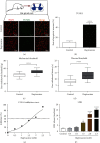The DNA Repair Enzyme XPD Is Partially Regulated by PI3K/AKT Signaling in the Context of Bupivacaine-Mediated Neuronal DNA Damage
- PMID: 34659643
- PMCID: PMC8516563
- DOI: 10.1155/2021/9925647
The DNA Repair Enzyme XPD Is Partially Regulated by PI3K/AKT Signaling in the Context of Bupivacaine-Mediated Neuronal DNA Damage
Abstract
Bupivacaine, a local anesthetic widely used for regional anesthesia and pain management, has been reported to induce neuronal injury, especially DNA damage. Neurons employ different pathways to repair DNA damage. However, the mechanism underlying bupivacaine-mediated DNA damage repair is unclear. A rat neuronal injury model was established by intrathecal injection of (3%) bupivacaine. An in vitro neuronal injury model was generated by exposing SH-SY5Y cells to bupivacaine (1.5 mmol/L). Then, a cDNA plate array was used to identify the DNA repair genes after bupivacaine exposure. The results showed that xeroderma pigmentosum complementary group D (XPD) of the nuclear excision repair (NER) pathway was closely associated with the repair of DNA damage induced by bupivacaine. Subsequently, Western blot assay and immunohistochemistry indicated that the expression of the repair enzyme XPD was upregulated after DNA damage. Downregulation of XPD expression by a lentivirus aggravated the DNA damage induced by bupivacaine. In addition, phosphatidyl-3-kinase (PI3K)/AKT signaling in neurons was inhibited after exposure to bupivacaine. After PI3K/AKT signaling was inhibited, bupivacaine-mediated DNA damage was further aggravated, and the expression of XPD was further upregulated. However, knockdown of XPD aggravated bupivacaine-mediated neuronal injury but did not affect PI3K/AKT signaling. In conclusion, the repair enzyme XPD, which was partially regulated by PI3K/AKT signaling, responded to bupivacaine-mediated neuronal DNA damage. These results can be used as a reference for the treatment of bupivacaine-induced neurotoxicity.
Copyright © 2021 Wei Zhao et al.
Conflict of interest statement
The authors declare no competing interests.
Figures







References
MeSH terms
Substances
LinkOut - more resources
Full Text Sources
Research Materials

